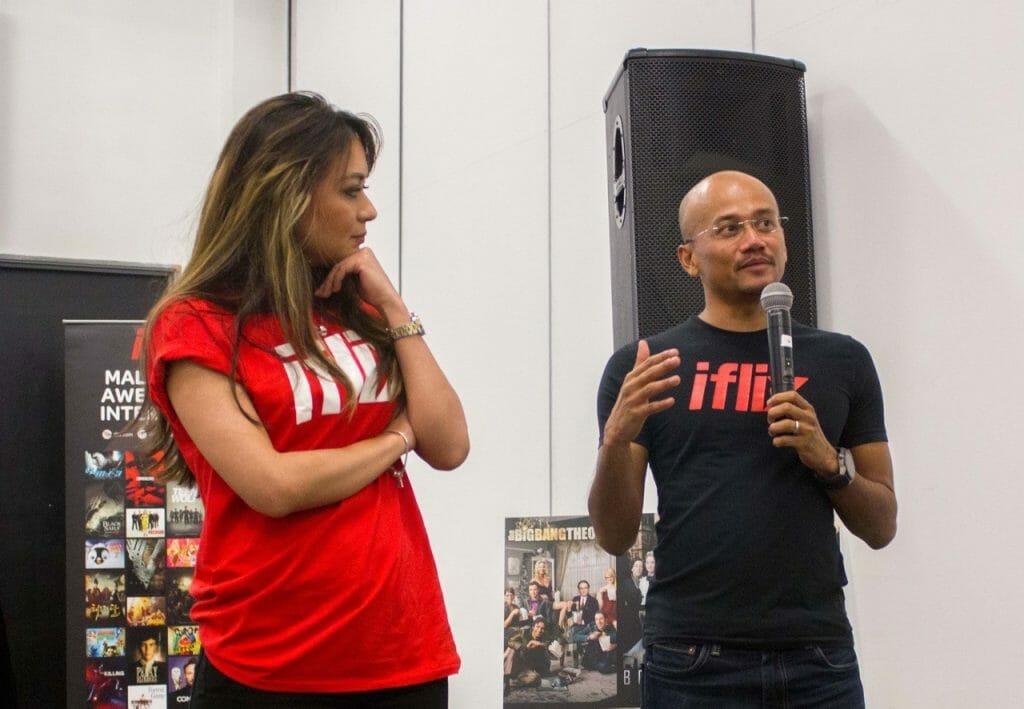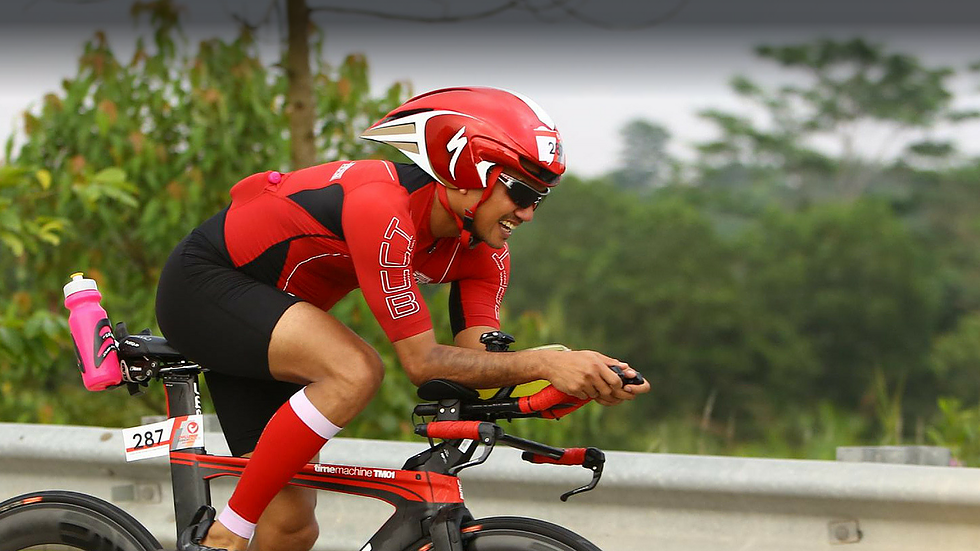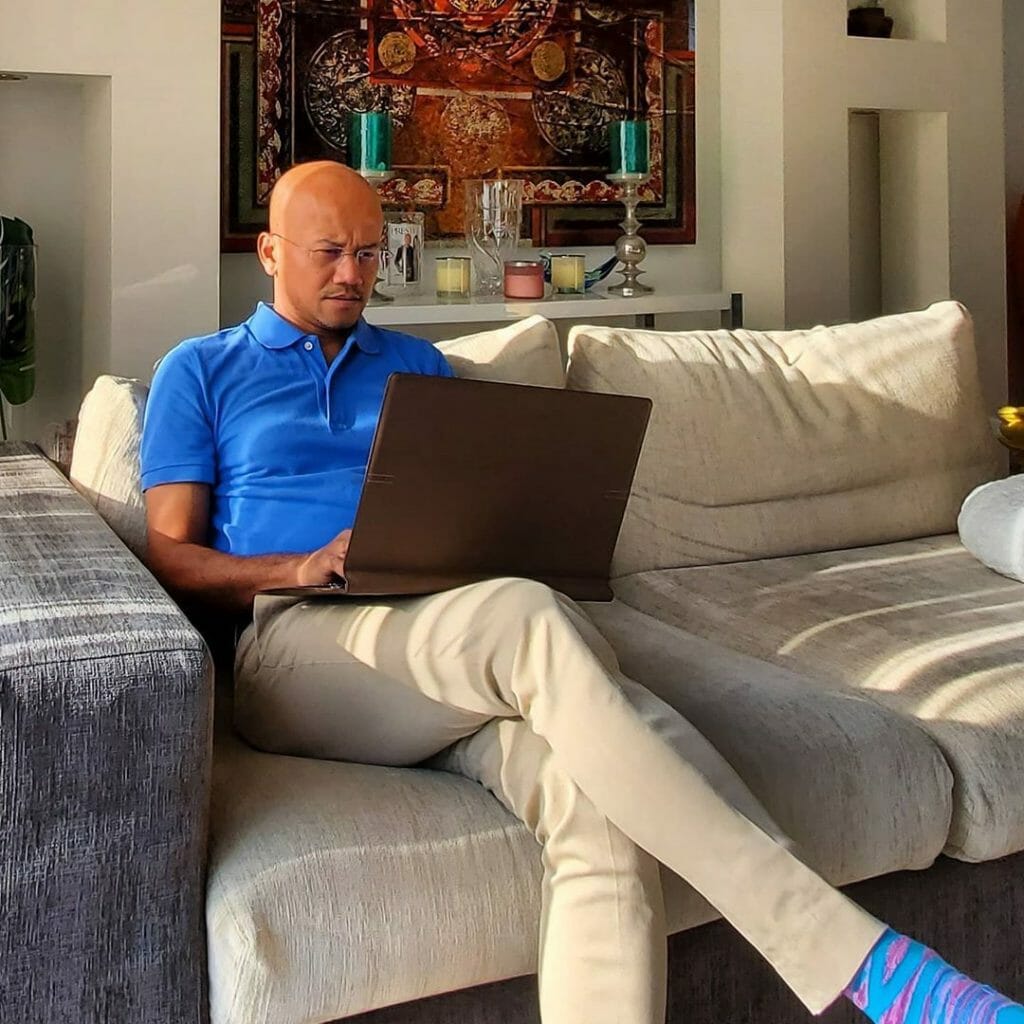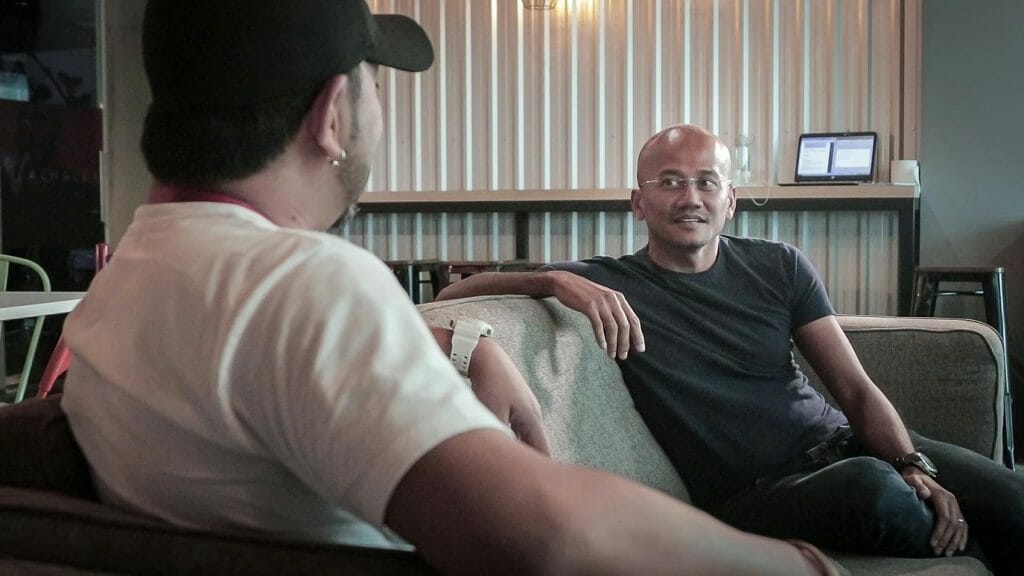Azran is no stranger to startups and disruptive businesses, having been at the helm of the expansion of AirAsiaX and brought iflix (Malaysia’s answer to Netflix) to the masses looking for local content.
 [Azran speaking on behalf of iflix.]
[Azran speaking on behalf of iflix.]
For someone who’s had nearly half a century of lived experience, Azran is spry and nimble.
Clad in a simple T-shirt and jeans, he gives off an energy of someone who’s always moving, even when he’s sitting still.
But the reason I was sitting down with him wasn’t to talk about his daring escapades in the business world.
It was to hone in on something far more personal — his own phobia of swimming.
What inspired you to overcome your fear of swimming?
I decided to overcome my fear of swimming after completing 12 marathons from 2009 to 2011, and was challenged to try triathlons — except I never learned to swim my entire life. I learned that the only thing standing in the way of something that seems impossible, is taking the first step.
I remembered how I first started venturing into endurance racing back in 2008, when I signed up for my first ever 10km run at the inaugural 2008 Borneo Marathon.
I thought completing a 10km run was something that pushed me to my limits, until I witnessed 60-70 year old grandparents completing a full 42-km marathon that day.
Just the day before, I thought only superhuman athletes could complete a 42km marathon.
Seeing senior citizens complete it with big smiles in their faces, triggered a sense of curiosity in me. I wanted to achieve what they achieved, and that started my journey into long-distance running.
The bigger challenge came after completing a dozen marathons and losing the interest for number 13. A friend suggested I try the sport of triathlon. Intriguing, but there was one big problem — I did not know how to swim. At all.
And I learned that if we keep avoiding what we fear, that fear only grows bigger inside us because avoiding it gives us a false sense of comfort.
The only way to deal with it, is to take the first step…
What was your process for overcoming your fear of swimming?
A lot of times we think of fear as something so big we donʼt know where to start.
Take swimming for example — I used to think swimming in the sea was too big a leap, so I wouldnʼt even start.
So I asked myself: “What is the easiest first step you can take to start?”

[Azran Osman-Rani had a phobia about water that lasted for decades — until his Borneo marathon experience in 2008 challenged his set of beliefs.]
For me, it was swimming lessons. I was in a waist-high pool, surrounded by preschoolers.
The teacher knew I was deathly afraid, so on Day 1, we just put our head underwater and blew bubbles — easy!
Day 2, she would throw coins into the water and I would dive down and get them. It was just a 4-foot deep pool, but it was daunting!
So we need to think about whatʼs the smallest, easiest step. It’s like building a staircase — you do it one step at a time.
After that, itʼs all about momentum, and momentum is about frequency.
What do you mean by “Momentum is about Frequency”?
For example, letʼs say you are overweight. You want to start exercising but your family & friends laugh at you.
But what if you had someone holding you accountable? Imagine if that someone said, “All we have to do today is put your running shoes at the door.”
 [Image via FrugalBeautiful]
[Image via FrugalBeautiful]
The next day, you just put it on. The following day, you go out for 10 steps. The third day, you do a brisk walking for 10-15 mins.
Youʼre building up small victories — before long, youʼre doing brisk walking for 10-15 minutes, you’re running around the lake, and so on.
With frequency, you build momentum — once you get started, it’s easier to keep going.
You love to run in triathlons — what got you into it?
After overcoming my phobia of swimming, I went on to complete multiple ironman triathlons from 2013 to 2018.
In a triathlon, youʼre on a bike for 6 hours, then you have to run for another 4 hours.
At 48, Iʼm not going to be a professional triathlete, but I love to train my ability to be comfortable with my thoughts, to not give up, to keep pushing through pain.

[Azran on his bicycle during one of his Triathlons. Image via Azran Osman-Rani. ]
You mentioned “Thinking Traps” — what are they?
Thinking traps are mental shortcuts you make, like: “All or Nothing” or “Black and White” thinking.
An example of “All or Nothing” is this: Let’s say youʼre on a diet. You see your colleagueʼs red velvet cupcakes, and then you break your diet to eat one.
Instead of resuming your diet, you beat yourself up and say, “Iʼll start a new diet tomorrow.”

[Azran working from home. Image via Tatler Malaysia.]
Are there any Thinking Traps you find yourself making?
For myself, I sometimes still think I’m an impostor.
People think Iʼm supposed to be this entrepreneur, and business-builder, but weʼre still struggling with Naluri — 60 investors rejected us while we were trying to raise money.
Itʼs hard, even with all my experience, to not have those self-defeating feelings.
 [Naluri is Azran’s passion project — a mental health tech startup that focuses on treating chronic diseases by addressing the mental health conditions that trigger them.]
[Naluri is Azran’s passion project — a mental health tech startup that focuses on treating chronic diseases by addressing the mental health conditions that trigger them.]
The way of overcoming the inevitable thinking traps is to carefully figure out who you spend time with — people who help you self-reflect and make you think.
Our friends and family, while well-intentioned, tend to be very keen on giving their own perspective: “Aiya, just do this, just take my advice.”
But itʼs not helpful if you only tell someone what to do. Thereʼs no emotional buy-in. Theyʼre doing it because someone told them to do it — and thatʼs why things donʼt last.
What Iʼve learned is to develop a support network of positive people to focus on what actions I can take.
What is your selection criteria for such a support network?
I have a small group of peers — Seven other CEOs who are closer to me than my childhood friends. We’ve been together for 10 years, and we meet 8 times a year.
Every meeting is very structured. Thereʼs an agenda, time keeping, and we share experience and take turns listening without judgement.
For most of us, there are far and few places we can open up about our deepest fears and anxieties, because we are afraid people will judge us.
 [Image via Azran Osman-Rani]
[Image via Azran Osman-Rani]
Shareholders donʼt want to see you being vulnerable — with my boss, my employees, my business partners, I need to project strength, macho-ness.
So even for us entrepreneurs, we need that safe space where we are trained to listen and ask questions that make us reflect.
Then we are able to make explicit the oft-times hidden fears and anxieties that are holding us back.
How do we vocalise the fears holding us back?
Itʼs not a simple formula; let me broaden this to ‘How do you win arguments?ʼ
Logic rarely wins arguments. Look at a recent example of people panic buying toilet paper — itʼs the emotion of fear that is driving them.
The first step is to affirm and validate peopleʼs fears: “I can understand where youʼre coming from.”
If you come across as an adversary, as someone trying to change their minds, they are going to box you in and disregard everything you say.
So how do you validate someoneʼs point of view? Figure out why they are feeling that way. Ask them: “Do you think this way because of that belief?” “Are you concerned about this?”
Then you figure out what ELSE they believe, that is in CONFLICT with that initial belief.
 [Image via ABC7NY]
[Image via ABC7NY]
For example, let’s say a friend of yours says, “I want to buy all the hand sanitisers at the pharmacy.”
Then you say, “But that means the sanitisers are going to run out of stock.”
“Yeah.”
“So, other peopleʼs hands will be dirty.”
“Yeah.”
“Do you want to have more sick people?”
“No.”
The technical term is cognitive dissonance — you sometimes need to have 2-3 months of conversations to figure out the contrasting belief that cannot logically coexist with the first belief.
What piece of advice would you give to someone who wants to overcome their fears?
Once you are clear on your purpose, you have a very specific direction youʼre heading to.
Here’s a test for identifying your purpose: If you read a lot about it, if you talk to a lot of people about it, that’s your purpose.

[Azran training for his next Triathlon.]
To sum up, here are the lessons learnt from my illuminating talk with Azran:
- Be Willing to Start
The first step is finding your purpose — what drives you to make a change?
- Identify Your Thinking Traps
Have you been stuck in a thinking trap like “All or nothing”, “Black and White” thinking? Find them and change them.
- Who Will be Your Mirrors?
Who are the objective people that you trust, have your best interests at heart, and who will give you feedback and observations that make you go “huh!”?
- Frequency Builds Momentum
The more you do something, the more momentum you build, and the less fear you feel doing it.
For more stories like this, read: Real People: How To Spot A Leader, A Follower, and A Rebel and Malaysians, what are some of the fears you’ve conquered so far?

You might also like
More from Real Mental Health
“I Was Scared of Waking Up in Handcuffs,” shares Depressed M’sian on Repealed Law
In 2023, Malaysia repealed Section 309, a colonial-era law that made suicide attempts a crime. The change marked a shift …
‘Everyone Saw A Successful Student While I Was Crumbling,’ Shares 22 Year Old Student
This is a story of a 22 year old woman who shared her story as a Straight A’s student as …
5 Harmful Mental Health Myths Malaysians Still Believe
Let’s break down five of the most common myths Malaysians still believe, and why it’s time to let them go.


















